According provided by Canon EOS-1D Mark II camera many thanks to Gleb Drobyazko.
The EOS-1D Mark II is the descendant of Canon's very first professional DSLR camera, the Canon EOS-1D, which appeared in November 2001. The Mark II came out in early 2004, the next model, the Mark III, came out in early 2007.
The Canon EOS-1D Mark II has a not very common APS-H sensor. There are only 5 cameras with this sensor size: Canon EOS-1D, 1D Mark II, 1D Mark II N, 1D Mark III, 1D Mark IV. Considering that the 1D Mark II N and 1D Mark II have the same sensor on board, we can assume that only 4 APS-H sensors have been developed. Since 2012, Canon APS-H cameras have been discontinued, and Canon's EOS line1D, EOS-1DSmost likely combined into one.
A lot of different information about crop factor APS-H cameras, to find out everything exactly, I performed small calculations:
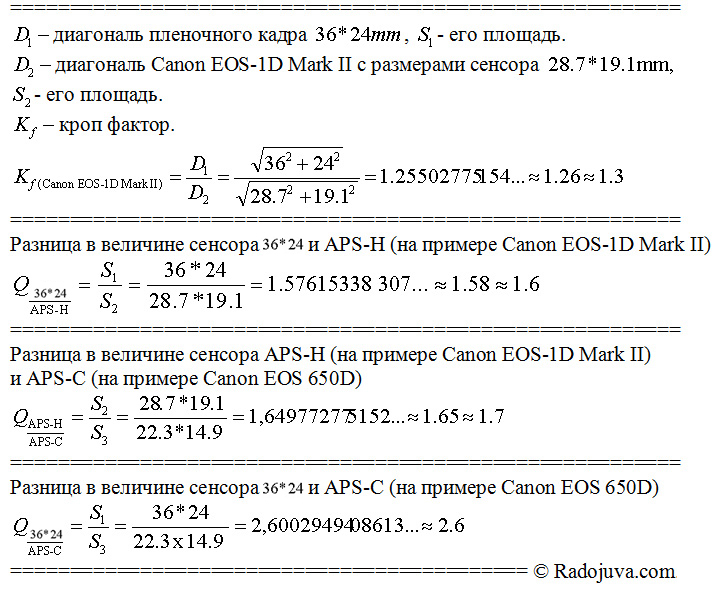
Crop factor and the difference in the physical sizes of the matrices. Matrix size Canon 650D is 22.3 x 14.9mm (proof link). Matrix size Canon EOS-1D Mark II is 28.7 x 19.1mm (proof link).
Thus, everything fell into place - the APS-H matrix, in physical dimensions, is 1.6 times smaller than the 36 * 24 matrix, and 1.7 times larger than the APS-C. Most likely, the appearance of cameras with APS-H sensors is associated with the time when Canon collaborated with Kodak and released cameras with digital backs. This is how the first Canon EOS cameras were created. DCS1 and Canon EOS D6000 using matrices with crop factor 1.3 (then they were not yet called APS-H). For more details on the development of Canon's digital control center, see the review of the first full-frame digital SLR camera - Canon EOS-1DS.
The Canon EOS-1D Mark II is an amazing machine. Like any professional Canon camera, the 1D Mark II has a rugged, dust and water resistant combo body that allows you to shoot in landscape and portrait modes without the need for an additional battery grip. The camera is heavy, weighing almost 1.5 kg. The controls are exactly the same as those of the 1D, 1Ds and 1Ds Mark II models, as all of these cameras are based on the same Canon EOS-1V film.
You need to get used to the controls. Personally, in 1D Mark II it’s inconvenient for me to poke around in the menu and make certain settings. If you set everything up and go directly to shooting, then holding and shooting with the 1D Mark II is very, very convenient :)
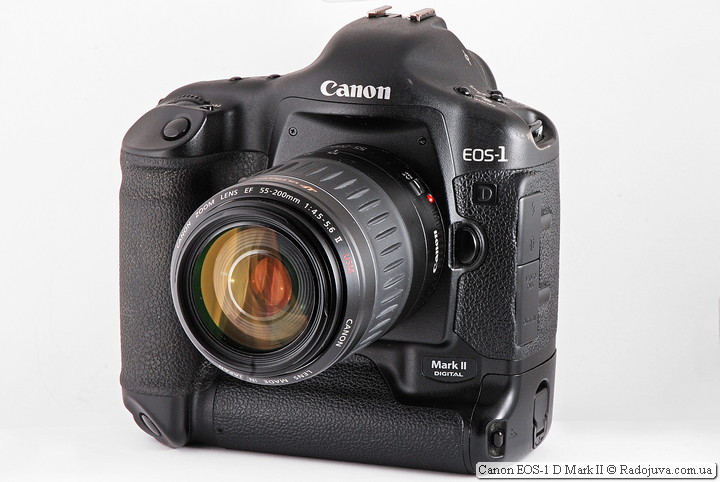
View of the Canon EOS-1D Mark II with a lens Canon Zoom Lens EF 55-200mm 1: 4.5-5.6 II USM
It is believed that the 'ones' (' EOS-1 D ', without the letter' S ') are cameras designed exclusively for reportage photography. Indeed, the 1D Mark II can shoot at 8.5 frames per second, which is very important for shooting action scenes. 8.5 fps is amazing speed, half a frame per second more than its predecessor. From such cameras, faster than 1D Mark II (for 2014) only 1D Mark III, 1D Mark IV, 1DX / DC and Nikon D3, D3s, D4.
The buffer of the 1D Mark II is not very large, the separator '/' shows the number of frames that are placed in the buffer when additional settings are disabled and enabled, such as extended ISO range and noise reduction.
- 20/18 RAW format shots
- 28/21 stills JPEG L (quality '10')
- 53/44 images JPEG S (quality '1')
- 18/16 shots RAW + JPEG L (quality '10')
In RAW format, 20 images will fit only when using ISO 100. At any other value, the buffer shows different numbers. I don't think 20 frames at 8.5 fps is a good indicator. RAW files have a 'CR2' extension and use 12-bit color depth, and weigh between 5 and 12 MB.
The 1D Mark II uses a CMOS sensor of just 8.2 MP, which can produce an image of 3504 X 2336 pixels. I have repeatedly emphasized in my articles that 8 MP, even in our time, is sufficient for a huge number of photo tasks. True, due to new processors, even the simplest modern cameras, for example Canon 100D, in its performance bypass the 'old lady' 1D Mark II.
Time takes its toll, and the meager range of ISO 100-1600 nowadays seems archaic. ISO can be expanded to ISO L equivalent to ISO 50, and ISO H equivalent to ISO 3200. The noise level is approximately the same as that of Canon 1DS. By modern standards, the 1D Mark II matrix is weak, but this does not change things if you need to get a good shot.
The 1D Mark II can only use Canon EF lenses. Unlike Canon APS-C cameras, for which special EF-S lenses are created, the focal length of which takes into account crop factor cameras, for APS-H cameras there are no special lenses. Therefore, for APS-H cameras, as well as for Canon D3o, D6o cameras, 10D (which do not support EF-S lenses) There is a theoretical problem with obtaining ultra-wide viewing angles when using Canon's native EF lenses.
The 1D Mark II uses a 45-point focusing system. The same focusing system can be found on the 1D, 1D Mark II N and 1DS Mark II cameras. Various focus settings are possible.
I know one story about the old "ones", which was told to me by a friend of the editor of a Kiev magazine. Canon EOS-1D Mark II and Canon EOS-1D Mark II N were used in the headquarters of photojournalists for a long time, at some point the management decided to replace them with something new. Apparently there was no money for Canon EOS-1D Mark III / IV, and therefore we bought a batch of Canon EOS 7D. According to rumors, employees of the headquarters were outraged for a long time both with the image quality and the 7D functionality they needed. Indeed, observing the development of camera engineering and testing many different cameras, I can agree that there is nothing better than a professional combo monster camera, even an old one and even with a small number of megapixels :)
For the first time among all Canon cameras, the 1D Mark II has the ability to use SD cards. The 1D Mark II from my review "made friends" with a 32GB SDHC card and a 32GB card without any problems CF. Also, in the 1D Mark II, for the first time, it became possible to use two memory cards, which is very, very useful, because the data backup function can, in case of emergency, save the photographer's 'life'.
The 1D Mark II uses a small 2-inch display with 230.000 dots. It is inconvenient to view the footage on it. For speed and ease of operation, there are also 2 monochrome displays (one on the top of the case, the other under the main screen) with blue backlighting. You can record an audio commentary on the captured photos, which will be stored in a separate file. The 1D Mark II does not have a built-in flash, but it does have a high-speed sync mode with external flash units. As befits a professional camera, the 1D Mark II has many useful features, such as minimal excerpt The shutter is 1/8000 s and the viewfinder provides 100% coverage.
Here link to the archive with the originals - 273 MB, 35 photos, RAW format.
Prices for modern Canon cameras in popular stores can look at this link.
In comments Can I ask you a question on the topic and you will answer, and you can also express your opinion or describe your experience. Many little things for a photo can be found on AliExpress.
Results
The Canon EOS-1D Mark II is an antiquated professional fast burst camera with an APS-H format sensor. The camera shutter is designed for 200.000 actuations, so it is quite difficult to 'kill' such a device, and nowadays the 1D Mark II can still be used by experienced photographers :)
Material prepared Arkady Shapoval. Training/Consultations | Youtube | Facebook | Instagram | Twitter | Telegram

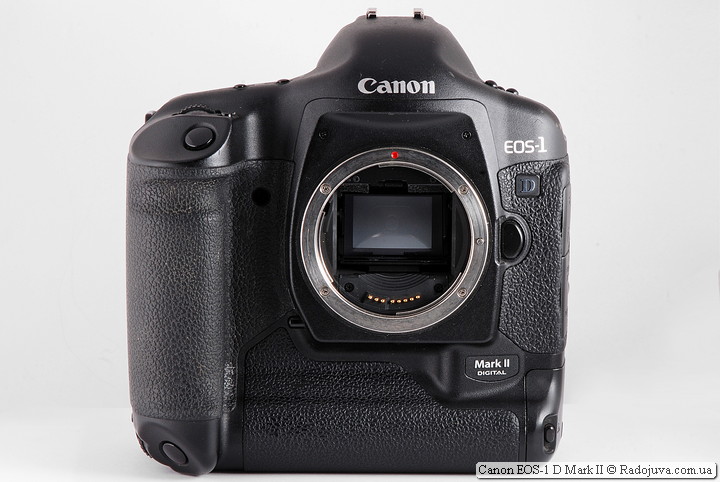
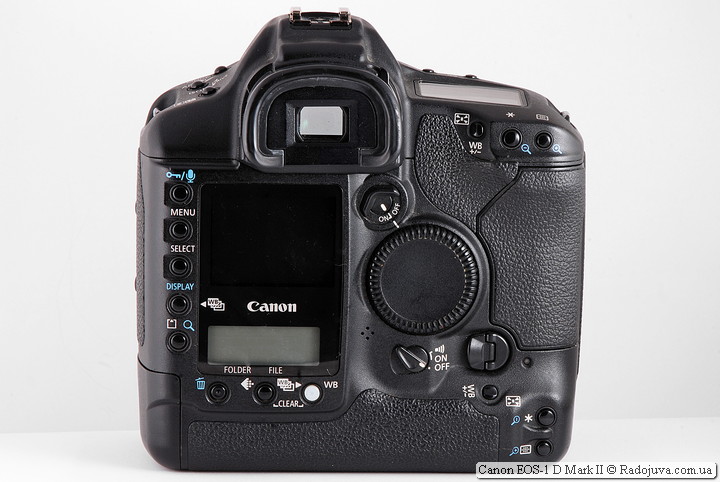
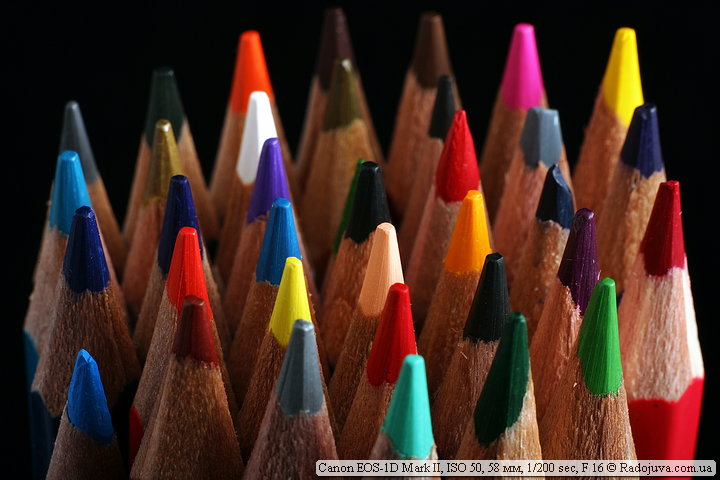
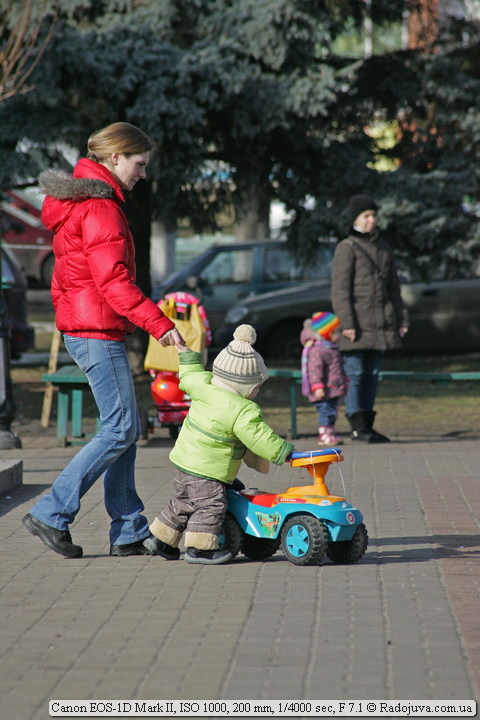

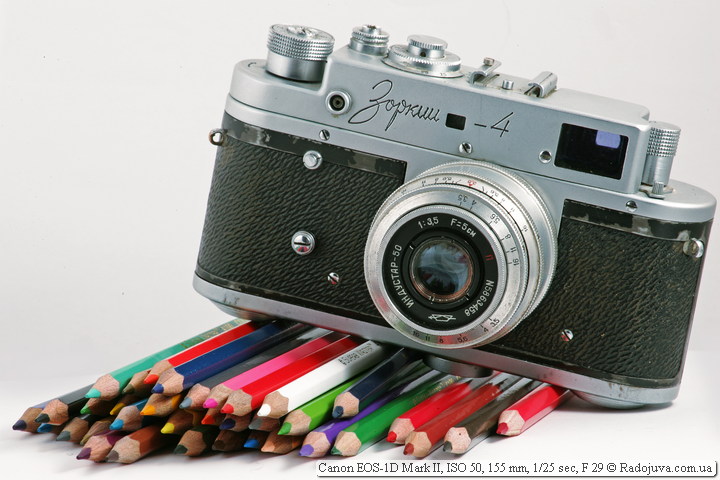
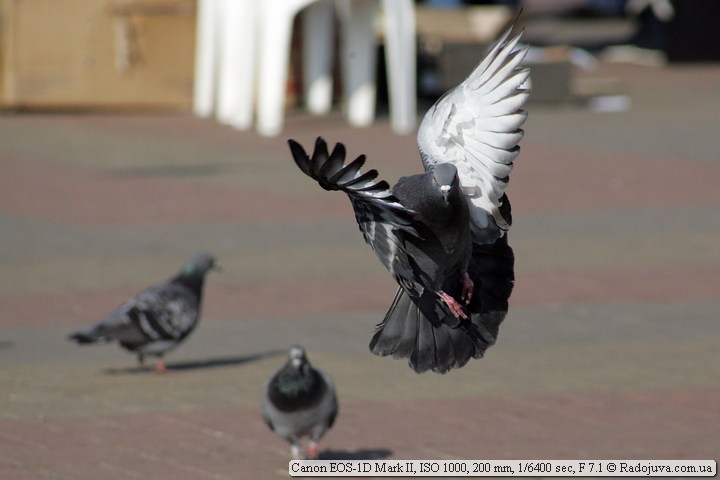

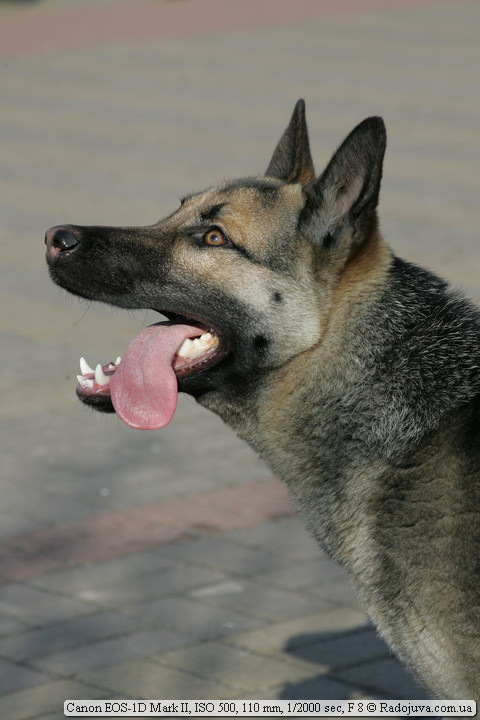

Many thanks to Arkady for the review.
The review proves once again that “ancient” cameras can be in demand today.
And with which lens did you take these pictures?
Macro on MC Helios 44m-4 2/58, the rest on Canon Zoom Lens EF 55-200mm 1: 4.5-5.6 II USM from the previous review https://radojuva.com.ua/2014/02/canon-ef-55-200mm-ii-usm/
Does Arkady write a canon 1d mark 2 video camera?
Does not write.
EF-S lenses, like, just did Canon itself? My Tamron, although designed for crop, has an EF mount and will fit both this camera and full-frame without any problems. The short focus will be vignetting, but most likely not very strong, and I think it will be possible to shoot without problems with a slightly larger focal length.
Third-party lenses (Tokina, Tamron, Sigma, Bower, etc.) for Canon crop cameras can also be mounted on Canon cameras with an EF mount. But the native EF-S lenses on cameras with a Canon EF mount cannot be installed. Why they did so is unknown.
Here I am about the same thing that only Canon EF-S did, which cannot be put on full-frame. I also don't understand why it was necessary to do this and how they got the benefit, even if nothing sticks out from third-party manufacturers and is placed anywhere, even over-widths ...
Everything is quite simple there. Two points: technical and marketing. You cannot set the EF-S to full frame because of the recessed rear element of the lens, about which a full-frame mirror will clatter.
1. Technical explanation from the Canon website - thus cropped optics are easier, smaller and cheaper than full-frame ones of the same performance characteristics.
2. The laws of marketing, however, argue that this is so that when switching from crop to full frame, the fleet of optics should be changed, from which Canon will undoubtedly benefit.
:) the pictures will be with black semicircular corners :)
Hello, I wonder if you consider the crop factor (diagonally), if you simply divide the sides 36 / 28,7, 24 / 19,1, then we get the same 1,256 without squares and roots.
and if the affective focal length is associated with the crop factor, then what is connected if you compare the area (in other words, why compare the area) I just don’t know and would be glad if they explained to me.
the difference in area APS / APS-c = 2,36, although I always considered 2,25, i.e. 1,5 squared, and for the example with Nikon d5100 and d800 cameras that have the same pixel size and the formula works 16 times 1,5 times squared (2,25) then we get 36,
the question is where is not matching?
The classic definition of the crop factor is the ratio of the frame diagonals (wiki), not all cameras have an aspect ratio of 2 to 3 (for example, the Olympus OM-D E-M1 has an aspect ratio of 4: 3). Also, the angle of view for lenses in the literature is indicated just along the diagonal of the frame - https://radojuva.com.ua/2014/01/calculon/... I compared the area for clarity, because this is a real indicator of the size of the camera sensor. You are not taking into account the fact that Nikon APS-C cameras have a crop of 1.5, and Canon - 1.6, details here - https://radojuva.com.ua/2013/06/aps-c-sensor-nikon-canon-size/
Then if Canon has 1.6 crop, then 24 * 36 / (22,5 * 15) = 2,56. And you have data for one and a half crops, it's just that manufacturers always “save a little”, so the real numbers are a little less.
Fixed
Look in the articles on the site - what is the crop factor
Ukraine is on fire, and you mean the carcasses. Give me some tips on how to shoot in hot spots and not get shot ...
I go to Radozhiva not to read about the Maidan, and so everywhere this Maidan, there is enough where to discuss. We must be able to be distracted.
Indeed, and so enough shocks, we will not breed offtopic here.
Cool. Finally, the people ceased to hang around and the Canons appeared. I am glad that this becomes even more versatile. Of course, it would be interesting to read about other photo equipment: tripods, belts, wardrobe trunks, etc.
I kept thinking that the stamps were full-frame, but not.
Tell me on the lenses, they did not change the bayonet mount from the film in Nikon and therefore there is a screwdriver on older carcasses. And on digital kenons from the very beginning go only motor lenses? I have never heard of a screwdriver in a canon.
When Canon switched from an FD mount to an EF, the entire focus and iris control system went completely over to the lens. Therefore, Canon cameras do not have a motor as such, for all Canon lenses are motorized and will work on all cameras. True, Canon has its own troubles.
there was no screwdriver on the electro-focus lenses from the boot. They even had a marketing trick that we have a motor in any lens and there is no difference between cheap and expensive carcasses when using them. True, the boot has its own catch - EF-S lenses will not fit full frame. So there is still class inequality, only the division according to a different principle
Please tell me what this filter is and how to take pictures with it ”sky 1a (la + 10) m72 (vii) Thank you in advance.
An ordinary protective filter with a slightly pink tint to shift the bb into warm colors. Typically, these filters are called Skylight.
Thank you!
So, canon EF is a canon mount, mount. EF stands for "electrofocus". Canon EOS is a line of cameras that has been around since the eighties to this day. We translate EOS as “electrician optical systems” - focusing using motors built into the lenses. From the late eighties to the present, all Canon DSLRs (including film) are all EOS, all with an EF bayonet mount. This means that your XNUMX year old film canon will fit the EF lens you bought yesterday. And vice versa - the twenty-five-year-old Canon EF lens will be on the mark bought yesterday. No confusion or confusion - everything fits everything for decades. The only exception is EF-S lenses, they are suitable only for digital croppers. EF-s glasses are quite small, these are simple amateur lenses, nothing special. To put this on a full frame is bad manners.
Oh, interestingly they wrote for decoding EOS, but what does Canon want to say in its long camera names by the abbreviation Mark? Almost all normal cameras from Canon with this Mark-irovka.
It's not at all a fact that the old ones will fit the new EFs and the new ones - the old ones. The exchange protocol changed during the release of EF and it is not at all a fact that everything will work.
I haven’t had any problems yet. Did not even hear about the incompatibility of kenon / kenon. Has anyone come across?
The old kenons didn’t come across, but somehow the cuantaray with the EF bayonet mount came across, the aperture did not work completely, the autofocus I don’t remember in any extreme position of the zoom showed an error, the original doubt about the serviceability of the lens itself ?,
after installation (again, I don’t remember long ago) on a series of 400 or 300, the glass worked perfectly, in the sense without problems, I used to say that the old canons are sinful, I myself haven’t seen it, I think that among very old glass there’s nothing to be interested in, either, of course, I and wrong but this is my personal opinion.
I came across. The 1000-35 zoom removed from the film EOS 70qd refused to work on the EOS 550d. More precisely, he focused, but when he tried to raise the flash on the camera, he displayed an unknown error.
I have ef28-70 sample '89. no problems were noticed on the 450d ...
Yeah, it sounds nice - mark, mark two, mark three, etc. This is just a continuation of this or that camera. 5D came out, it turned out to be successful, gained superpopularity, sold a decent circulation, is obsolete - 5D mark two comes out, then three. Like Volkswagen golf - one, two, three, etc. Naturally, this applies to expensive professional cameras. For 450D, for example, making mark two is pointless. The 550D just comes out. This is marketing.
And which flash will work best on this camera?
native 430 and above
Any native Kenon flash of speedlite ex - .. would be better; third-party also fit, read more. There is no built-in flash in the camera, as in all prof.
I took myself recently, used. true but in good condition and with a range of 65t. I think a good replacement 20D ..
Very high quality camera. The mileage of my mark 2 n 430000, another one lying on a friend, left 450000 shutter releases. Of the 28 editorial marks, only these two did not fall apart, 300 thousand, for which they were written off. They continue to work, to please now.
Thanks for the review, I’m shooting it myself with this camera.
Anonymous \\\ EF-s glasses are quite few, these are amateur simple lenses, nothing special. To put this on a full frame - Moveton.
It’s not even a matter of movement, when you raise the mirror in full format, it can touch the far protruding end of the lens, hence the rubber protective ring on it, so it’s technically impossible to use EF-S lenses on Canon full frame cameras
Sorry, I forgot to write the name in the top post, and the article is very informative, thanks
can I ask a question about helios on a 1D carcass? when installed at infinity, the mirror does not cling to the rear optical element? the fact is that it clings to 5D ..
thanks in advance
On my Canon 1d mark II N, Helios 44-2 touches at infinity, the problem is solved by sawing the back, at 20m it does not catch
Tell me please, is it worth buying a new device for such a device? I plan to shoot wedding photo albums. Found on an ad with a shot 95tys. What could be the problem with such a run?
And tell me which lenses to buy for this device?
As for the problems - it's hard to say - if a successful one comes across, then 2 more times it runs out. And so different things happen - look at http://www.olegkikin.com/shutterlife/canon_eos1dsmkii.htm
In principle, he should still work out a hundred without problems. Long-lasting apparatus. For weddings, the Canon 5d will probably be better - after all, full frame - there is less noise in poor light (that is, with a higher ISO) - and you will be shooting weddings not only in perfect lighting.
Lenses - on joy they are very well described - look in the reviews - and then according to the budget. In any case, a portrait lens with good aperture and width is useful. Look at USM lenses - focusing speed is also important in your case
My Canon 1D Mark III plows like a horse, and mileage 1 006 785, imagine !?
Thank you for the article! I recently bought a used carcass, but I can’t decide on a lens. I plan to shoot portraits (to a greater extent). Can someone tell me the most suitable option? It is also interesting to learn about the universal lens.
I would be grateful for the advice!
For a single unit, aperture lenses are usually recommended according to the instructions, in your case the universal EF 24-70mm f / 2.8L II USM will work great (multiply by crop factor x1.3)
In general, at one time I took two second units for work, one died with a mileage of 500 frames, the second still works. So, when I bought it, one took only the carcass, the second went whale with EF 000-28mm f / 135-3.5 IS USM, it seems not so fast but worked well, but there is one important point with f / 5.6, autofocus works significantly faster and everything is activated autofocus points, focus becomes more accurate, faster and more accurate.
Aperture f / 2.8 activates 39-45 points plus a cruciform in the center.
Aperture f / 4 activates 26-44 points.
Aperture f / 5.6 activates 16-39 points.
Tell me. Will this unit support Sigma 50 / 1,4?
in sense autofocus will be?
Something did not understand about a bayonet mount?
Of course it will be if it is Sigma for Canon, I myself use a fifty dollars on the second unit as a constant and fast lens.
Universal is considered 24-105L.
Good afternoon! Why when you put on a Soviet lens: helios, jupiter ... Error 1 pops up? There is no connection between the camera and the lens. Maybe you need to disable or enable something in the camera settings? Help to disassemble?
In the camera settings, you need to select: shooting without a lens - allowed
Then the carcass will not request connection contacts.